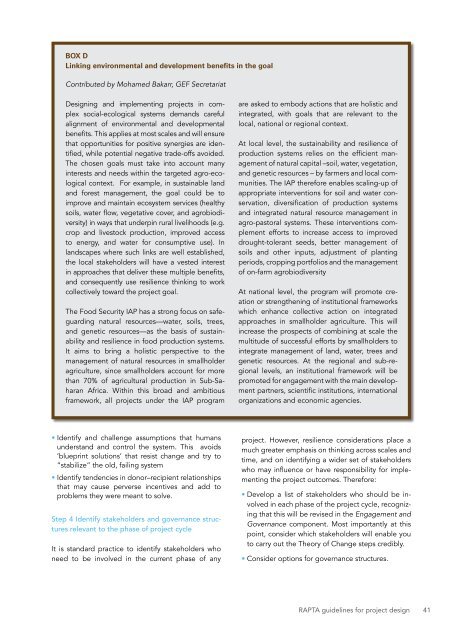DESIGNING PROJECTS IN A RAPIDLY CHANGING WORLD
srun3013fp1
srun3013fp1
You also want an ePaper? Increase the reach of your titles
YUMPU automatically turns print PDFs into web optimized ePapers that Google loves.
BOX D<br />
Linking environmental and development benefits in the goal<br />
Contributed by Mohamed Bakarr, GEF Secretariat<br />
Designing and implementing projects in complex<br />
social-ecological systems demands careful<br />
alignment of environmental and developmental<br />
benefits. This applies at most scales and will ensure<br />
that opportunities for positive synergies are identified,<br />
while potential negative trade-offs avoided.<br />
The chosen goals must take into account many<br />
interests and needs within the targeted agro-ecological<br />
context. For example, in sustainable land<br />
and forest management, the goal could be to<br />
improve and maintain ecosystem services (healthy<br />
soils, water flow, vegetative cover, and agrobiodiversity)<br />
in ways that underpin rural livelihoods (e.g.<br />
crop and livestock production, improved access<br />
to energy, and water for consumptive use). In<br />
landscapes where such links are well established,<br />
the local stakeholders will have a vested interest<br />
in approaches that deliver these multiple benefits,<br />
and consequently use resilience thinking to work<br />
collectively toward the project goal.<br />
The Food Security IAP has a strong focus on safeguarding<br />
natural resources—water, soils, trees,<br />
and genetic resources—as the basis of sustainability<br />
and resilience in food production systems.<br />
It aims to bring a holistic perspective to the<br />
management of natural resources in smallholder<br />
agriculture, since smallholders account for more<br />
than 70% of agricultural production in Sub-Saharan<br />
Africa. Within this broad and ambitious<br />
framework, all projects under the IAP program<br />
are asked to embody actions that are holistic and<br />
integrated, with goals that are relevant to the<br />
local, national or regional context.<br />
At local level, the sustainability and resilience of<br />
production systems relies on the efficient management<br />
of natural capital –soil, water, vegetation,<br />
and genetic resources – by farmers and local communities.<br />
The IAP therefore enables scaling-up of<br />
appropriate interventions for soil and water conservation,<br />
diversification of production systems<br />
and integrated natural resource management in<br />
agro-pastoral systems. These interventions complement<br />
efforts to increase access to improved<br />
drought-tolerant seeds, better management of<br />
soils and other inputs, adjustment of planting<br />
periods, cropping portfolios and the management<br />
of on-farm agrobiodiversity<br />
At national level, the program will promote creation<br />
or strengthening of institutional frameworks<br />
which enhance collective action on integrated<br />
approaches in smallholder agriculture. This will<br />
increase the prospects of combining at scale the<br />
multitude of successful efforts by smallholders to<br />
integrate management of land, water, trees and<br />
genetic resources. At the regional and sub-regional<br />
levels, an institutional framework will be<br />
promoted for engagement with the main development<br />
partners, scientific institutions, international<br />
organizations and economic agencies.<br />
• Identify and challenge assumptions that humans<br />
understand and control the system. This avoids<br />
‘blueprint solutions’ that resist change and try to<br />
“stabilize” the old, failing system<br />
• Identify tendencies in donor–recipient relationships<br />
that may cause perverse incentives and add to<br />
problems they were meant to solve.<br />
Step 4 Identify stakeholders and governance structures<br />
relevant to the phase of project cycle<br />
It is standard practice to identify stakeholders who<br />
need to be involved in the current phase of any<br />
project. However, resilience considerations place a<br />
much greater emphasis on thinking across scales and<br />
time, and on identifying a wider set of stakeholders<br />
who may influence or have responsibility for implementing<br />
the project outcomes. Therefore:<br />
• Develop a list of stakeholders who should be involved<br />
in each phase of the project cycle, recognizing<br />
that this will be revised in the Engagement and<br />
Governance component. Most importantly at this<br />
point, consider which stakeholders will enable you<br />
to carry out the Theory of Change steps credibly.<br />
• Consider options for governance structures.<br />
RAPTA guidelines for project design 41


